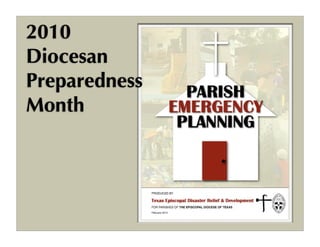
Parish Emergency Planning
- 2. Why Prepare? Photo: www.texasescapes.com
- 3. Why Prepare? Photo: www.washington.edu
- 4. Why Prepare? Photo: www.satromaranch.com
- 5. Why Prepare? Photo: NASA
- 6. Why Prepare? ‣ Acknowledge our vulnerability in considering the worst possible scenarios that could affect us. ‣ Take precautions to minimize the effects of a crisis situation and maximize our ability to recover quickly. ‣ Equip ourselves to assist others, responding with love to an affected community.
- 7. How do I prepare? ‣ Put together a team. ‣ Establish parish priorities. ‣ Identify your risks. ‣ Make preparedness part of your regular maintenance schedule. ‣ Secure your facilities.
- 8. How do I prepare? ‣ Make an evacuation plan. ‣ Create a communications plan. ‣ Help to ensure that your parishioners are protected. ‣ Connect with community disaster groups. ‣ Review and update your plan annually.
- 9. Step One: Assemble a Team ‣ Elect a Parish Emergency Coordinator. ‣ Form a Parish Emergency Committee. 11
- 10. Step Two: Establish Priorities Mission of the Episcopal Diocese of Texas in Times of Crisis: To serve Episcopalians and their neighbors. 13
- 11. Step Two: Establish Priorities ‣ Consider the composition, culture, and particular needs of your parish. ‣ Consider partner ministries associated with and/or included in your church community. ‣ Identify priorities specific to your parish. 13
- 12. Step Three: Identify Risks ‣ Research local crisis history. ‣ List out all events of the past 50 years, including both man-made and natural disasters. ‣ Think about crises that could affect your community, including even the most extreme. ‣ List out all possible crises. 15
- 13. Step Three: Identify Risks ‣ Rank historical and possible crises, and identify the emergencies most likely to occur. ‣ Mentally walk through each of the most likely disasters. ‣ Find out how you will receive warning, and what the procedures are for evacuation or shelter-in-place, if necessary. 16
- 14. Step Three: Identify Risks ‣ Walk through parish facilities, noting areas of particular vulnerability. ‣ Identify ways to reduce hazards. 18
- 15. Step Four: Maintenance ‣ Complete a full inventory of parish property and holdings annually. ‣ Store a copy of the completed inventory off- site or online. ‣ Record insurance contact information. 19
- 16. Step Four: Maintenance ‣ Check all hazard alarms, including fire and carbon monoxide. ‣ Install additional alarms or replace where necessary according to the recommendations of local authorities. Photo: www.avongov.org 19
- 17. Step Four: Maintenance ‣ Train all staff and ministry leaders in the use of fire extinguishers. ‣ Post instructions for us and local fire officials contact information. ‣ Check extinguishers to ensure that you’re using the right type for each type of fire. 19
- 18. Step Four: Maintenance Classifications: http://www.hanford.gov/fire/safety/extingrs.htm
- 19. Step Four: Maintenance ‣ Put together at least one first-aid kit. ‣ List out the parishioners, staff, and ministry leaders trained and certified in first aid and CPR. ‣ Encourage others to get trained. Photo: www.fieldskills.com 21
- 20. Step Five: Secure Facilities ‣ Know who has access to the building at all times. ‣ Train staff, vestry members, and key ministry leaders in disarming the security system. 23
- 21. Step Five: Secure Facilities ‣ Record the location of and instructions for shutting off each utility. ‣ Train, staff, clergy, and ministry leaders. Photo: www.commgassolutions.co.uk 24
- 22. Step Five: Secure Facilities ‣ Identify important files and records. ‣ Store securely on-site and off-site or online. ‣ Keep a list of passwords and user names for all computers, software, and Photo: www.state.nj.us websites utilized by the parish. 25
- 23. Step Six: Plan for Evacuations ‣ Identify essential items to remove from parish in an evacuation. ‣ Create a “church in a box” containing all items essential to holding services. ‣ Identify alternate operations/worship sites. 27
- 24. Step Seven: Communications ‣ Gather information from all parishioners, including phone numbers, home addresses, email addresses, and evacuation destinations. ‣ Create a plan for contacting parishioners and update annually. ‣ Identify persons authorized to address the media. 29
- 25. Step Eight: Serving Parishioners ‣ Never assume your parishioners will be safe in an emergency, or that they have taken the recommended precautions. ‣ Identify vulnerable persons within your congregation and help to ensure that they will also be safe. 31
- 26. Step Nine: Connect ‣ Identify community organizations and officials who are or will become active in disasters. ‣ Introduce yourself, know how to contact them, and let them know how to contact you when disaster strikes. 33
- 27. Step Nine: Connect ‣ Partnering with another parish provides an opportunity to both serve others and to receive services in an emergency. ‣ Establish a relationship with a parish in another region of the diocese, not susceptible to the same emergencies at the same time as your parish. 35
- 28. Final Steps ‣ Fill out the summary at the end of the workbook and send to Russ Oechsel, Co- Diocesan Emergency Coordinator for the Diocese of Texas. ‣ Set an annual review date. 39
- 29. Questions?